Abstract
Alpine glaciers are sensitive indicators of regional climate change, which can affect regional ecological stability and social development. Variations in glacier mass balance (GMB) are an important parameter in studying glacier change. In this study, data from the Ice, Cloud, and Land Elevation Satellite-1 (ICESat-1), the Ice, Cloud, and Land Elevation Satellite-2 (ICESat-2), and CryoSat-2 (Ku-band) were combined, and high-resolution ALOS DEM was employed to denoise. After that, the polynomial fitting method was used to analyze the characteristics of glacier surface elevation (GSE) variations from 2003–2020 in the Tomur Peak Region of the Central Asian Tianshan Mountains and the regional GMB was calculated. Research results showed that: (1) From 2003–2020, the GSE of the Tomur Peak Region had an overall −8.95 ± 4.48 m variation, the average rate of which was −0.53 ± 0.26 m/yr (/yr is /year). Overall, elevations of most glaciers in the Tomur Peak Region had downward trends, with a rate of change of −0.5 to 0 m/yr. The fastest rate of elevation decline in the Koxkar Glacier Tongue was −1.5 m/yr. The elevation of some altimetric points in the Eastern Tomur Peak Region showed a rising state, with a maximum rate of variation of 1.0 m/yr. (2) From 2003–2020, the average GMB in the Tomur Peak Region was −1.51 ± 0.04 Gt/yr. In the region of elevation below 4000 m, small glaciers dominated, with a GMB of −0.61 ± 0.04 Gt/yr. With increasing elevation, the melting rate of glaciers gradually slowed down, but overall, the mass balance remained in a state of decline. (3) Climate was the main driving factor of GMB change in the study area. From 2003–2020, in the Tomur Peak Region, the average annual temperature continued to increase at a rate of 0.04 ± 0.02 °C/yr, and this was the main influencing factor for the negative GMB in the Tomur Peak Region. In the same period, the annual precipitation showed a rising trend with a linear variation rate of 0.12 ± 0.06 mm/yr, and the rising precipitation was the influencing factor for the gradually slowing change in the GMB in the study area.
1. Introduction
Glaciers play an important role in the global climate system and are sensitive indicators of global climate change, with important implications for regional water circulation, climate regulation, and human survival [1,2,3,4]. According to the Sixth Assessment Report (AR6) released by the Intergovernmental Panel on Climate Change (IPCC) on August 9, 2021, it was stated that the global cryosphere has been undergoing accelerated shrinkage over the past decade [5]. Glacier ablation has resulted in an increased frequency of related natural disasters, such as ice collapses, glacial debris flows, glacial lake outburst floods, and so on, even threatening the life safety of people living in downstream areas [6,7,8]. As a source of many rivers in the arid regions of Central Asia, glacier changes in the Tianshan Mountains (TSMs) ensure regional water resources, the ecological environment, and socio-economic development in the surrounding area [9]. The glaciers in the Tomur Peak Region, which account for 17.81% of the glacier area of the TSMs, are also important for maintaining ecological stability and sustainable economic development in the surrounding area [10]. Therefore, in this study, monitoring the glaciers of this region holds practical significance for ecological conservation, disaster prevention and mitigation, and water management.
Variations in glacier surface elevation (GSE) are indicators for the changes occurring in regional glaciers. Due to the severe natural conditions, field surveys in glacier regions are so time-consuming and challenging that fewer than 120 glaciers worldwide have conventionally filed survey data, and just 39 glaciers have more than 30 years of measurements [11]. Developing remote sensing technology provides more data sources and technical tools for glacier research. Data from Landsat, the Ice, Cloud, and Land Elevation Satellite-1 (ICESat-1), the Ice, Cloud, and Land Elevation Satellite-2 (ICESat-2), Cryosat-2, and other satellites were used to estimate glacier surface velocities, elevations, volumes, and mass balance [12,13,14,15]. Estimating elevation changes and further calculating surface mass balance have been the research focuses of many studies. There are different approaches to monitoring glacier elevation changes using remote-sensing data. The method of using DEM to obtain GSE was used initially, but the signals from radar sensors can penetrate the ice and snow and impact the accuracy of elevation estimations, so penetration depth correction is widely used for glacier monitoring [16,17]. Lhakpa et al. [18] estimated the penetration depth of an SRTM (C band) DEM in ice/snow by using an SRTM (X band) DEM, while Ali et al. [19] used ICESat-2 ATL06 data for NASA DEM penetration depth correction to analyze glacier elevation variations. The InSAR technique is usually used to obtain time-series analyses of glacier surface deformation. The technology of monitoring glacier variations using SAR has been developed for years. When glaciers with terrain complexity are monitored by InSAR, the results may have inherent limitations or shortcomings, and reliable geospatial information cannot be obtained because of layover, foreshortening, shadows, and other factors [20]. To overcome SAR distortion errors, Yan et al. [12] produced a DEM from Sentinel-1 satellite imagery. After co-registration of the SRTM DEM and InSAR DEM, they selected non-glacial regions to correct the InSAR DEM and extracted the topographic parameters corresponding to each point from the SRTM DEM by bilinear interpolation. To overcome the limitation of decorrelation, Zohreh Erfani Jazi et al. [21] generated multiple interferograms by using a stack of SAR acquisitions, which were analyzed by InSAR time-series techniques to obtain a time series of surface deformation. This approach is known as multi-temporal InSAR (MT-InSAR) and is extensively used to obtain time series information on surface deformation.
In 2003, with the launch of ICESat-1, which carried the Geoscience Laser Altimetry System (GLAS), remote sensing and monitoring of snowy and icy environments began to have a specific satellite. Subsequently, CryoSat-2, ICESat-2, and other satellites were launched for long time-series observations of global glaciers. Kääb et al. [22] measured glacier volume variations in eastern Svalbard, Norway using the Advanced Spaceborne Thermal Emission and Reflection Radiometer (ASTER) satellite and ICESat-1/GLAS data. Thomas Slater [23] estimated the elevation variations in the Greenland ice-sheet melting zone using CryoSat-2, and directly estimated the variations in runoff in the study area based on the seasonal surface elevation variations in the ice-sheet. Junhao Wang et al. [24] studied elevation and mass changes in Svalbard from 2019–2021 using ICESat-2 data and the results indicated that the study area showed a negative mass balance within that period. As ICESat-1 stopped working early in 2010 and ICESat-2 was postponed to 2018 for reasons including design modification, detection demand cannot be matched by using ICESat series satellites only; thus, it is necessary to combine the altimetry satellite data from multiple sources to study long time-series glacier variations. For example, Zhao F et al. [25] monitored the GSE variation and glacier mass balance (GMB) of the southeastern Tibetan Plateau for 20 years by combining ICESat-1/2 and CryoSat-2 with DEM and Gravity satellite data, and revealed that there were significant spatial variations in glacier mass loss in this region. Yubin Fan et al. [26] combined ICESat-2, NASADEM, and SRTM DEM to remove elevation outliers and estimated the elevation variations and GMB in High Mountain Asia (HMA) from 2000–2021. The results of this study suggested that the largest mass loss occurred in southeastern HMA and that all basins in HMA had experienced mass loss. Vikram Goel et al. [27] worked with ICESat, ICESat-2, and CryoSat-2 to investigate mass balance variations in the Five Ice Rises in Dronning Maud Land, Antarctica. Their study indicated that altimetry satellites with higher spatiotemporal resolution were better at estimating seasonal elevation variations in glaciers and revealing GMB.
Several scholars have monitored glacier changes in the Tomur Peak Region. Pieczonka et al. [28] utilized Terra ASTER and Landsat images to determine glacier surface velocity, and they used KH9 DTM for volume change calculations to investigate the GMB of the Tomur Peak. Qifei Zhang et al. [29] calculated the GMB of the Central Asian Tianshan, employing LSDPC snow depth and MODIS snow cover data, supplemented by the ERA-Interim dataset and ASTER DEM data. The results indicated that glacier mass budgets for the area south of Tomur Peak were negative from 1974–2014. Several scholars, such as Huai Baojuan [30], Changbin Bai [10], and Shujing Yang [31], investigated the variations in glaciers in the Tomur Peak Region by employing Landsat data. The research findings indicated that the surface velocity of glaciers in the Tomur Peak Region exhibited a significant deceleration during the period from 2000–2020. The lower glacier melt rate in this area can be attributed to the combined effect of decreased bare ice exposure and increased debris coverage. Considering that there has been limited research using altimetry data to monitor glacier variations in the Tomur Peak Region in recent years, after analyzing the characteristics of altimetry satellites in terms of their working cycles and spatiotemporal resolutions, the present study decided to use satellite altimetry data from ICESat, ICESat-2, and CryoSat-2 to conduct long-term monitoring of the GSE and GMB variations in the Tomur Peak Region.
The main research contents are as follows: (1) Constructing a polynomial fitting model with processed multi-source satellite altimetry data to obtain the fitting GSE in the study area and constructing the temporal variation in the average GSE in the study area. (2) Obtaining the GMB variations in the study area by interpolating the annual average rate of variations in GSE calculated from the satellite altimetry data. (3) Incorporating the meteorological dates and analyzing the glacier surface mass balance. The main objective of this study is to provide relevant references for research on glacier changes in the Tomur Peak Region.
2. Data and Methods
2.1. Study Area
The TSMs are located in Eurasia (37°N–46°N, 66°E–95°E), with a length of about 2500 km from east to west and an average width from north to south of 250 to 350 km. The total area of the TSMs is approximately 135.5 × 104 km2 [32]. The TSMs are divided into the Western Tianshan, Eastern Tianshan, Northern Tianshan, and Tomur Peak Region according to the geographical location and spatial distribution. The study area of this research is located in the Temur-Khan Tengri Tomur Range, which is located in the central part of the TSMs (Figure 1). It represents the largest and most glacier-rich area in the TSMs, with a significant number of glaciers. Furthermore, there are over 40 peaks with elevations exceeding 6000 m in this area [33]. The study area includes Tomur Peak, the highest peak of the Tianshan Mountains, with an elevation of 7443.8 m and a total glacier area of approximately 3849.5 km2, located in the Kumalak River Basin [34]. In the study area, the glacier ablation period occurs from May to September, while the glacier accumulation period takes place from October to April in any given year. Influenced by the prevailing westerlies, approximately 70% of the annual precipitation is concentrated in summer [35,36]. Snowfall, as a form of precipitation in high-altitude regions, serves as the primary source for glacier development in the Temur-Khan Tengri Range. In the Tomur Peak Region, glaciers contribute to the main tributaries of the Tarim River, Ili River, and Syr Darya River in the form of glacial meltwater. During the dry summer season, this glacial meltwater provides a significant portion of freshwater supply to the areas near the rivers [10].
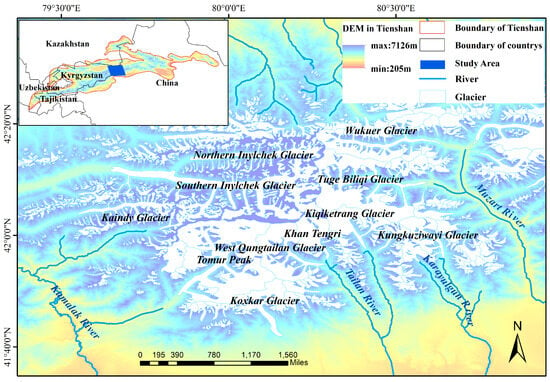
Figure 1.
General situation and distribution of glaciers in this study area. ALOS DEM was used as the background. Khan Tengri is situated at a geographical location of 80.2°E longitude and 42.2°N latitude. It stands as the second-highest peak in the Tien Shan mountain range, with an elevation of 6995 m. Positioned to the east is Mount Tumu-Khan Tengri.
2.2. Data
2.2.1. ICESat-1 and ICESat-2 Laser Altimetry Data
ICESat-1 was a satellite mission launched by NASA in 2003 with a revisit cycle of 91 days, and carried the Geoscience Laser Altimeter System (GLAS) [37]. The footprint diameter of ICESat-1/GLAS was approximately 70 m, and the spacing between adjacent footprints along the ground track was approximately 170 m. In this study, we utilized the ICESat-1/GLA14 data from 2003–2009. The GLA14 data product is GLAS Level 2 global surface elevation data, providing information such as latitude, longitude, elevation, and ellipsoid correction parameters at the laser footprint locations [38]. The data can be downloaded from the National Snow and Ice Data Center (NSIDC) at https://nsidc.org/data/glah14/versions/34 (accessed on 10 April 2022).
ICESat-2, the successor of ICESat, was successfully launched in September 2018. It carries the Advanced Topographic Laser Altimeter System (ATLAS) as its payload [39]. With 1387 orbits, ICESat-2 provides global coverage of the Earth’s surface. In comparison to its predecessor, ICESat-2 exhibits significant improvements in data coverage density, data accuracy, and spatial resolution. In this study, we utilized the ICESat-2 L3A Land Ice Height data product (ATL06). This dataset includes latitude, longitude, elevation, time, and other parameters for each measured footprint. The spatial resolution of the data is approximately 20 m [40]. The data can be downloaded from the EARTHDATA platform at https://search.earthdata.nasa.gov/ (accessed on 10 April 2022).
2.2.2. CryoSat-2 Radar Altimetry Data
CryoSat-2 was launched in 2010, and is equipped with the Ku-band Synthetic Aperture Radar Interferometric Altimeter (SIRAL) [41]. SIRAL operates in multiple modes including low-resolution mode (LRM), synthetic aperture radar (SAR) mode, and SAR interferometric (SARIn) mode. The SARIn mode, in particular, is valuable for monitoring glaciers in complex terrains due to its high along-track resolution of 0.3 km and across-track resolution of 1.65 km [42]. CryoSat-2 provides various data products, including L1B, L2, and L2I, which correspond to different levels of data processing. Compared to the previous Baseline-C product, the CryoSat-2 L2 Baseline-D product offers improved results for land ice [43] and reduces the impact of track deviations on the estimation of ice surface elevation variations [44]. In this study, we utilized the L2 Baseline-D data of the SARIn model between 2010 and 2020 to estimate the GSE variations. The data can be downloaded from the European Space Agency (ESA) at https://earth.esa.int/eogateway/missions/cryosat/data (accessed on 10 April 2022).
2.2.3. ALOS DEM
ALOS DEM is derived from the Advanced Land Observing Satellite (ALOS) mission. The ALOS satellite carried the Phased Array L-band Synthetic Aperture Radar (PALSAR) sensor, operating in the L-band (wavelength of 23.6 cm). In glacier activity detection, PALSAR, with its phased array antenna, has been extensively utilized and has demonstrated excellent accuracy [45,46,47]. ALOS was operational from 2006–2011, and its fine beam single polarization (FBS) mode offers a resolution of 12.5 m [48]. ALOS PALSAR data, including its RTC (radiometric terrain-corrected) products, can be accessed through the Alaska Satellite Facility (ASF) data search portal at https://search.asf.alaska.edu/ (accessed on 1 November 2022).
2.2.4. Auxiliary Data
The Randolph Glacier Inventory (RGI) 6.0 includes information on the worldwide outlines, areas, and various attributes of glaciers such as elevation, length, and volume. The RGI serves as a valuable resource for studying glacier dynamics [49,50]. The RGI dataset is freely available and can be accessed through the Global Land Ice Measurements from Space (GLIMS) website at http://www.glims.org/RGI/ (accessed on 6 November 2022).
ERA5 refers to the fifth-generation atmospheric reanalysis dataset produced by the European Centre for Medium-Range Weather Forecasts (ECMWF) [51]. The reanalysis process combines a variety of observational data, satellite measurements, and numerical weather models to a globally complete and consistent dataset, primarily for climate monitoring, meteorological research, and forecasting, with a temporal coverage from 1959 (back to 1940) to the present [52]. The ERA5 product has a temporal resolution of 1 h and a spatial resolution of 0.25° × 0.25° [53]. The data can be downloaded from the ECMWF website at https://www.ecmwf.int/en/forecasts/datasets/reanalysis-datasets/era5 (accessed on 6 November 2022).
2.3. Time-Series Reconstruction of Glacier Surface Elevation Variations
2.3.1. Altimetric Point Denoising
In this study, more stable altimetry data from autumn (October to November) were selected for analysis. Although ICESat-1/2 and CryoSat-2 L2 elevation data had been corrected to mitigate the effects of clouds, precipitation, and satellite footprint size, the data may still contain some outliers. Therefore, in this study, a denoising technique was applied to the acquired satellite altimetric points [54]. The main steps for denoising are below.
Taking the elevation difference between the altimetric point and the datum DEM as , values greater than the threshold were eliminated as gross errors, satisfying:
where is the elevation of the altimetry satellite footprints in glaciers, is the elevation of the datum DEM, and is the absolute elevation accuracy of the datum.
Taking the elevation difference between each satellite footprint and the datum DEM as , where is the total number of satellite footprints, the average of the elevation differences is and the standard deviation is . The probability () that the difference between the satellite footprints and the datum DEM falls within is as follows:
where is the elevation difference of the th satellite footprint. When corresponded to a normal distribution (in this method, three times the standard deviation), the elevations greater than three times the standard deviation were eliminated as outliers. When did not follow a normal distribution, outliers that were multiple standard deviations away from the mean were eliminated.
RGI6.0 can filter the altimetric points within the range of glaciers in the Tomur Peak Region. As an example, CryoSat-2/SIRAL 2016 data were used to test whether the elevation of footprints corresponded to normal distributions. According to the Kolmogorov-Smirnov (K-S) test and the Shapiro-Wilk (S-W) test, the significance of CryoSat-2 footprint elevations was less than 0.05 (Table 1). Consequently, the elevations of the footprints in the Tomur Peak Region do not follow a normal distribution. Based on the test results, values that deviate by more than one standard deviation from the mean were selected as outliers and subsequently removed to ensure the accuracy of the data.

Table 1.
Normal distribution test of CryoSat-2 footprint elevation in the Tomur Peak Region in 2016.
ICESat-1/2 and CryoSat-2 data before and after denoising were fitted with DEM for comparison, and Figure 2 shows some of the comparison results. Most data were fitted well in the fitting process, but several laser points were still affected by cloud cover, altitude, and slope, resulting in higher fitted elevations [55].
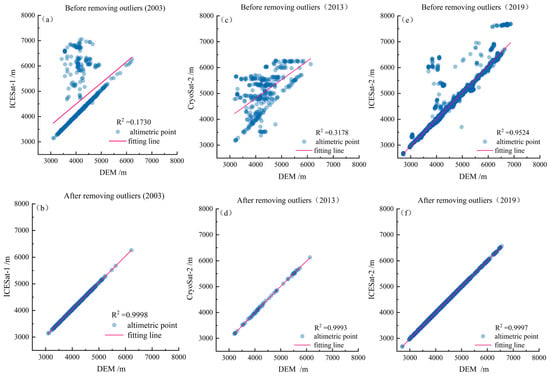
Figure 2.
Comparison of the Ice, Cloud and Land Elevation Satellite-1 (ICESat-1), the Ice, Cloud and Land Elevation Satellite-2 (ICESat-2), and CryoSat-2 data before and after the removal of outliers.
2.3.2. Construction of the Polynomial Fitting Function Model
We thus developed a polynomial fitting function model to improve the spatial and temporal consistency of the footprints of ICESat-1/2 and CryoSat-2, with the selected datum DEM as the independent variable and the elevation of altimetry data as the dependent variable. Subsequently, we established the functional relationship between the satellite elevation and DEM elevation in interannual/seasonal time series, then calculated the correlation coefficient ():
where is the datum DEM elevation corresponding to the altimetric point, corrects the elevation data, and a fitting coefficient 0.95 is required.
According to the constructed polynomial fitting function model, each DEM elevation was substituted as the dependent variable, and the corresponding value of y, i.e., the simulated elevation of each altimetric point, was calculated separately. Then, the average was taken as the elevation at that time point, and the time-series during the study period was obtained according to the time alignment.
Due to the extensive dataset spanning a long period utilized in this study, only a subset of specific function models was presented in Figure 3. The formulas shown in the figure represent the specific models for each region during each period.
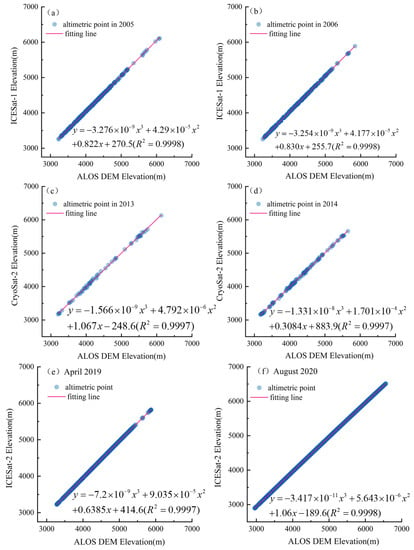
Figure 3.
Fitting images of ICESat-1/2 and CryoSat-2 data to ALOS DEM, respectively. Where (a,b) are the results of fitting ICESat-1/GLAS data to ALOS DEM, (c,d) are the results of fitting CryoSat-2/SIRAL data, and (e,f) are the results of fitting ICESat-2/ATLAS data.
2.3.3. Accuracy Assessment for the Polynomial Fitting Function Model
Considering that fitted elevations of the altimetric points were estimated based on the digital characteristics between the reference DEM and the corresponding altimetric points, this study has decided to evaluate the systematic errors in the ICESat-1/2 and CryoSat-2 data by using statistical methods. The aim was to reduce the impact of errors between data sources on the accuracy of glacier variation results. The statistical metrics coefficient of determination () was used to evaluate the polynomial fit for GSE [54]. is given as follows:
where is the sum of the squares of the differences between the fitting elevation and the average of the original elevation, is the sum of the squares of the differences between the original elevation and the mean elevation, is the sum of the squares of the errors between the points of the fit and the original data, and . The decreases and approaches 1 when the error decreases between the fit and the corresponding points of the original data. As the decreases, the more explanatory power the variables in the equation have for the predicted elevation, y, and the better the fit. The fitting results are given in Table 2.

Table 2.
R2 of the polynomial fitting model for the study area from 2003–2020.
2.4. Glacier Mass Balance Estimation
By reconstructing the long-term GSE variations for each altimetry point on the glacier, approximations of the GSE variations rate for a specific measurement point over a period of time was obtained. However, it should be noted that satellite altimetric points are limited by factors such as orbital spacing, revisit period, and the topography of the study area. Therefore, the GSE changes calculated based on satellite altimetric points only represent the GSE variations where the altimetric points are located and may not accurately reflect the overall glacier changes in the study area. To address this limitation, interpolation was performed on each altimetric point within the study area based on the obtained change rates of the satellite altimetric points. This ensures that the final grid covers the entire glacier region. Additionally, glacier area and density are incorporated to calculate the GMB.
This paper estimated the GSE variation in the 100 m × 100 m grid with time-series variation data. After that the GMB in the study area can be estimated from the GSE variation in the grid.
The GMB is estimated by an equation called the mass conversion model, as follows:
where is the GMB in a grid and the unit is m w.e./yr; is the rate of GSE variation within the study area time series; represents common ice density (, as the introduction of errors); and is water density () [26].
The GMB at the null grid is found by counting the pattern of GMB versus GSE variations for all grids in a single area or region, meaning the GMB of a single glacier or region can be counted. For a single glacier, the variation in GMB in a grid is transferred to the single or regional glacier mass variation, and the equation is as follows:
where is the single glacier or regional glacier mass variation and the unit is Gt/yr, is the single glacier or regional glacier area, and is the water density.
3. Results
3.1. Surface Elevation Variations in the Tomur Peak Region
3.1.1. Interannual Variations in Glacier Surface Elevation in the Tomur Peak Region
To construct an interannual variation in the long time series, this study combined ICESat-1/GLAS (2003–2009) and CryoSat-2/SIRAL (2010–2020) to obtain the 2003–2020 altimetry data time series while increasing the number of altimetric points in the study area to ensure the reliability of the results. Additionally, another precision ICESat-2/ATLAS (2019–2020) with greater accuracy and coverage density was also selected to increase the number of altimetric points in the study area. To facilitate the analysis of the annual variation in GSE and to avoid bias due to the temporal variation in the snow height, altimetry data from autumn (October to November), when snow accumulation was lowest in the Tomur Peak area, were selected.
The interannual average variation in GSE in the Tomur Peak Region is shown in Figure 4a, and the GSE in the Tomur Peak Region shows an obvious decrease and a larger interannual variation rate. Examining the period from 2003–2020, the average GSE in the Tomur Peak Region decreased from 4175.56 m to 4161.51 m in 2014 and then rose back to 4166.62 m in 2020, with an overall decrease in glacier elevation of 8.95 ± 4.48 m and an average rate of GSE variation of −0.53 ± 0.26 m/yr. This result is consistent with the glacier thinning of −0.52 m/yr obtained by Bai et al. [10]. The GSE variation in the Tomur Peak Region from 2003–2008 was −2.35 ± 1.63 m, showing a decreasing trend (−0.47 ± 0.32 m/yr). The GSE from 2011–2020 showed a trend of decreasing and then increasing, with a variation of −3.73 ± 2.35 m, and the rate of decrease was slow and gradual. The average variation in GSE in the Tomur Peak Region is shown in Table 3. The interannual variation in the average GSE of the Koxkar Glacier is shown in Figure 4b, the GSE of which decreased from 4027.58 m in 2003 to its lowest elevation of 4011.36 m in 2014, before gradually increasing to 4016.50 m in 2019 and decreasing again by 1.01 m in 2020. Overall, the average GSE of the Koxkar Glacier decreased cumulatively by 12.08 ± 6.55 m from 2003 to 2020, with an average annual rate of variation of −0.71 ± 0.42 m/yr. The GSE variation graph of the Kiqikterang glacier is shown in Figure 4c; its elevation decreased from 4087.52 m to 4071.73 m in 2014 and then increased to 4077.39 m in 2020. Additionally, in 2019 there was an elevation maximum of 4077.91 m. The cumulative GSE variation in the Kiqikterang glacier from 2003–2020 was 10.13 ± 5.35 m at a rate of −0.60 ± 0.31 m/yr. These two small glaciers had overall similar trends, with both being at elevation minima in 2014, experiencing maximums in 2019, and then declining again. During the period of 2003–2008, the overall variations estimated from ICESat/GLAS were −2.20 ± 1.62 m and −2.48 ± 1.54 m, at variation rates of −0.44 ± 0.33 m/yr and −0.50 ± 0.30 m/yr, respectively, in the Koxkar and Kiqikterang Glaciers. From 2011–2020 the two GSE variations estimated from CryoSat-2/SIRAL data were −4.67 ± 2.87 m and −4.12 ± 2.34 m, corresponding to average annual decreasing rates of 0.53 ± 0.32 m/yr and 0.46 ± 0.25 m/yr, respectively. During these two periods, the Kiqikterang glacier maintained a consistent trend with the overall variation from 2003–2020, the variation rate of glaciers in 2011–2020 slowed down compared to 2003–2008, while the Koxkar Glacier maintained a relatively fast variation rate.
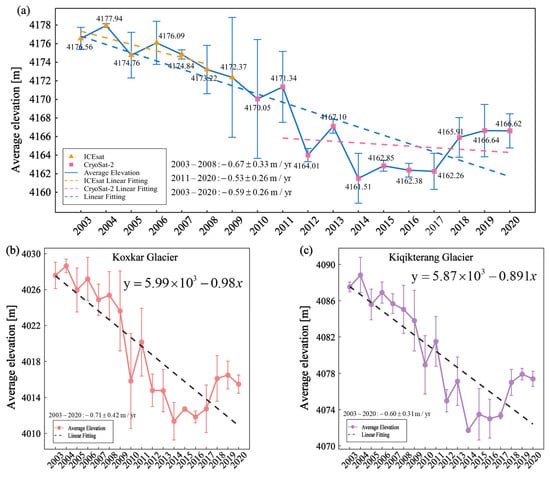
Figure 4.
Time series of the average variations in glacier surface elevation in the Tomur Peak Region from 2003–2020. (a) is the average elevation variation in the Tomur Peak Region; (b) is the average elevation variations in the Koxkar Glacier; (c) is average elevation variations in the Kiqikterang Glacier.

Table 3.
The average variation in GSE in the Tomur Peak Region from 2003–2020. GSE is the glacier surface elevation.
3.1.2. Monthly Variations in Glacier Surface Elevation in the Tomur Peak Region
As shown in Figure 5, this study calculated the monthly average elevations in the Tomur Peak Region from 2019 to 2020, and the results showed that the GSE reached the maximum value in February each year, 4256.70 m and 4257.91 m, respectively. Then, the GSE showed a continuous decrease, reaching its lowest values in July and August, with 1.23 m and 2.97 m decreases, respectively. After that, it kept a slowly increasing trend until February of the following year. In the Tomur Peak Region, the GSE was 4256.51 m in winter 2018 and 4255.59 m in spring 2019 (March–May), which decreased by 0.02% compared to winter 2019 and decreased by 0.12 m compared to spring 2020. The summer (June–August) GSE in 2019 was 4255.26 m, which was similar to the GSE in the summer of 2020, with a GSE of 4255.14 m. The fall (September–November) GSE in 2019 was 4255.93 m, which was an increase of 0.67 m compared to the summer, and a decrease of 0.58 m compared to the elevation in the fall of 2020. The most significant GSE variation was that from fall to winter in 2019, when the GSE value increased by 1.04 m.
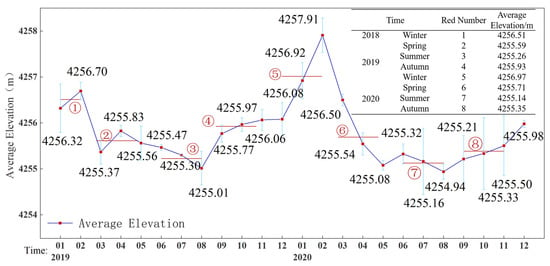
Figure 5.
Monthly average variation in glacier surface elevation in the Tomur Peak Region from January 2019 to December 2020. The red sequence marks indicate the location of the seasonal average elevation.
3.2. Spatial Distribution of Glacier Mass Balance in the Tomur Peak Region
As shown in Figure 6, in this study, the distribution of GMBs in the study area was calculated for different periods, and the results showed mass loss rates of −0.08 to 0 (10–3 Gt/yr) in the majority of glacier areas, especially from 2003–2008. Glacier mass loss was present to various degrees in the Koxkar Tongue, Tomur Peak, South Inerichek, and Tugbilizi glaciers. The mass loss of these glaciers was significantly greater than that of glaciers in other regions of the study area, and the GMB was similar to some small glaciers in the northeastern study area with the maximum GMB loss in 2011. The area of GMB accumulation was concentrated near Tomur Peak. The area of positive GMB decreased as time went on and the GMB line rose to higher altitudes. All indications suggest that the glaciers have been in an ablation state.

Figure 6.
Glacier mass balance in the Tomur Peak Region during different study periods. The periods of (a–c) are 2003–2008, 2011–2020, 2003–2020, respectively.
As shown in Figure 7, this paper studied the variability characteristics of some single glaciers. Both the Koxkar Glacier and the Qingbingtan No. 72 Glacier are to the south of Tomur Peak, with the Koxkar Glacier having an elevation of 3020–6342 m and an area of about 83.56 km2 [56] and the Qingbingtan No. 72 Glacier having an elevation of 3560–5986 m, an area of 6.6 km2, and a length of 7.4 km [57]. The two glaciers have similar latitudes and longitudes, and they are theorized to have similar variations in mass balance, so the two glaciers were chosen to confirm each other. The mass balance of both glaciers showed a significant trend of variation. The mass loss of the glacier in the low elevation area at the end of the glacier tongue was more serious, and the loss gradually decreased with increasing elevation, shifting from negative GMB values to positive ones. The two glaciers selected in this paper differ greatly in scale, but obviously the glacier ablation decreased, and glacier accumulation even occurred in the high-altitude area, which indicated that high altitude has an obvious inhibitory effect on glacier ablation.
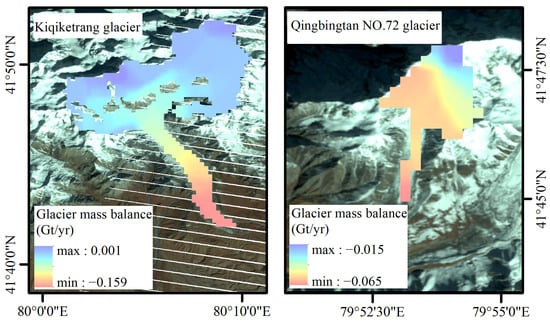
Figure 7.
Variation characteristics of single glacier mass balance in the Tomur Peak Region from 2003–2020.
In this paper, we also divided the glaciers in the study area into six different sub-regions according to the distribution of terrain and river basins, and the GMB of each sub-region was provided in the figure (Figure 8). The highest rate of glacier mass loss was in region I, with a GMB of −0.38 ± 0.05 Gt/yr, followed by region III, with −0.30 ± 0.04 Gt/yr. The smallest variation in GMB was only −0.09 ± 0.02 Gt/yr in region VI.
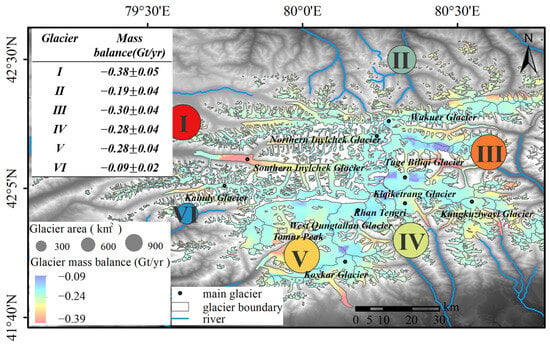
Figure 8.
Glacier mass balance in different areas of the Tomur Peak region.
4. Discussion
4.1. Analysis of Glacier Variations in the Tomur Peak Region
Figure 9 illustrates the spatial distribution of interannual GSE variations in the Tomur Peak Region. In Figure 9, the points were denoised altimetry data from ICESat-1/GLAS, CryoSat-2/SIRAL, and ICESat-2/ATLAS, and each point represented the average rate of GSE variations at a neighboring footprint site. From an overall perspective (Figure 9c), most glaciers in the Tomur Peak Region decreased at the rate of −0.5 to 0 m/yr, with a maximum decrease of −1.5 m/yr at the end of the Koxkar Glacier Tongue; some areas had positive variation rates, mainly around points c and d in Figure 9, with a maximum accumulation rate of 1.0 m/yr. From 2003–2008 (Figure 9A), GSE variation rates at the majority of glacier elevation points ranged from −0.5 to −0.7 m/yr, with individual elevation points decreasing as fast as −0.89 m/yr. From 2011–2020 (Figure 9B), although individual elevation points decreased much faster than −0.7 m/yr, such as that at the end of the Koxkar Glacier Tongue, most of the elevation points decreased at a range from −0.5 to 0 m/yr, with a significant slowdown in GSE compared to 2003–2008. In Figure 9, the GSE variation rates of some glaciers to the north and especially northeast of Tomur Peak were significantly faster than variation rates of the neighboring glaciers, most of which are small glaciers. Small glaciers experienced loss faster than large glaciers. Four points in different elevation ranges were selected from all the altimetric points in the Tomur Peak Region (Figure 9C). The greatest variation in elevation was at point a, which decreased from 3516.60 m to 3496.36 m, with an average annual rate of variation of −1.19 ± 0.01 m/yr; point b was the next highest, with an absolute elevation decrease of 12.43 m and an average rate of variation of −0.73 ± 0.01 m/yr; point d increased in elevation by 6.5 m, with an average annual rate of variation of +0.38 ± 0.03 m/yr. With the increasing elevation, the GSE variation gradually changed from negative to positive, i.e., it gradually changed from ablation to accumulation.

Figure 9.
Elevation variation rates of altimetric points in the Tomur Peak Region during different periods. The periods of (A–C) are 2003–2008, 2011–2020, 2003–2020, respectively. Four points (a–d) in different elevation ranges were selected from all the altimetric points in the Tomur Peak Region.
As shown in Table 4, this study divided the study area into 100 m-interval elevation bands based on elevations and classified the glacier extent and glacier area of each elevation band with RGI 6.0. Based on this, GMB variations at different elevations in the Tomur Peak Region were calculated for different study periods. Yubin Fan [26] estimated the mass balance of Asian alpine glaciers by using this method with ICESat-2 and NASADEM data from 2000–2021 and obtained better results. From 2003–2020, the mass balance variation rate for the whole study area was −1.51 ± 0.04 Gt/yr, where the average glacier mass loss rates from 2003–2008 and 2011–2020 were −1.42 ± 0.05 Gt/yr and −1.15 ± 0.04 Gt/yr, respectively. According to the relationship between GMB and glacier elevation (Figure 10), it was observed that the GMB variation gradually changed from negative to positive with increasing elevation. From 2003–2020, the mass balance variation rate for the whole study area was −1.51 ± 0.04 Gt/yr, where the average glacier mass loss rates from 2003–2008 and 2011–2020 were −1.42 ± 0.05 Gt/yr and −1.15 ± 0.04 Gt/yr, respectively.

Table 4.
Glacier elevation variation rates and mass balance at different elevations in the Tomur Peak Region.
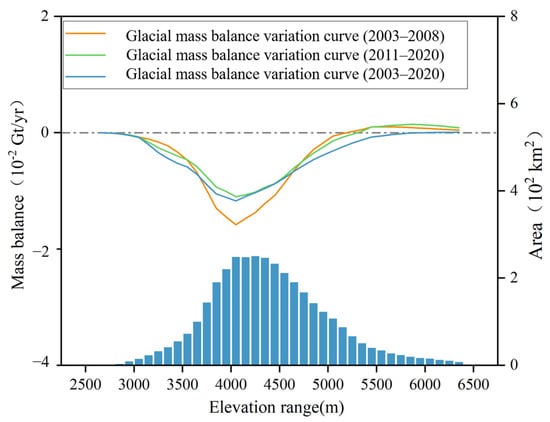
Figure 10.
Variation in glacier mass balance with altitude in the Tomur Peak Region.
According to the relationship between GMB and glacier elevation (Figure 10), it was observed that the GMB variation gradually changed from negative to positive with increasing elevation. In the elevation region below 4000 m, small glaciers are dominant and account for about 25% of the total area; here, the GMB was −0.61 ± 0.04 Gt/yr. With increasing elevation, the glacier ablation rate gradually slows down; in the region above 5000 m, although smaller regions of positive GMB occurred, the overall was still in a negative GMB state.
4.2. Analysis of Factors Influencing Mass Balance Variations in the Tomur Peak Region
The analysis of climate change in glacier regions is essential for understanding the patterns of glacier variations, as climate serves as the primary driving factor for glacier changes. The increasing temperature will cause glacier ablation and decreasing glacier mass, and there is a negative correlation between temperature and GMB; precipitation is one of the factors of glacier accumulation, and there is a positive correlation between precipitation and GMB, which increases the glacier accumulation and contributes to increasing glacier mass [29,58]. The Tomur Peak Region has an average elevation above 4000 m, with low temperatures and relatively abundant precipitation on windward slopes under the influence of the prevailing westerlies in the TSMs. To investigate the response of the GMB to climate change in the Tomur Peak Region, this paper analyzed the temperature and precipitation changes by using ERA5 reanalysis data in the Tomur Peak Region and then analyzed the factors influencing the GMB variations.
As shown in Figure 11, the average annual temperatures in the Tomur Peak Region continued to increase from 2003–2020, with a warming rate of 0.04 ± 0.02 °C/yr. The region is characterized by high elevation and low temperatures, with an annual average temperature of −7.59 °C. The highest temperatures reached only around 5 °C each year, while the lowest temperatures dropped to around −20 °C. The area experienced an increasing trend in annual precipitation, with a change rate of 0.12 ± 0.06 mm/yr. The annual accumulated precipitation was around 26 mm, primarily concentrated between June and August. The findings regarding the increase in temperature and the increase in precipitation aligned with the conclusions of Yang Shujing et al. [31] on the region’s climate becoming warmer and wetter from 1960–2020. In the southern Tomur Peak region, the Ak-su River basin has experienced an increase in precipitation at a rate of 2.26 mm/yr, while the temperature has risen at a rate of +0.038 °C/yr. On the other hand, [59], the Kumalak River has shown a slower temperature increase (0.013 °C/yr) but has experienced a significant growth in annual precipitation at a rate of 2.04 mm/yr [29].
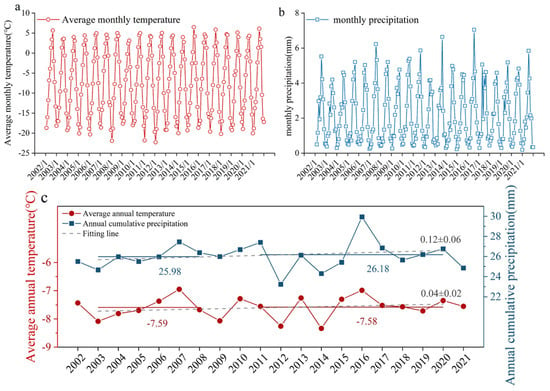
Figure 11.
Temperature and precipitation curves in this figure. The (a) is the average monthly temperatures in the Tomur Peak Region from 2003–2020, the (b) is the monthly precipitation in the Tomur Peak Region from 2003–2020, the (c) is the curves of annual average temperature and annual average precipitation in the Tomur Peak Region from 2003–2020.
In this study, the average temperature from 2011–2020 was generally consistent with that of 2003–2008 in the Tomur Peak Region, but the precipitation was slightly higher than that of 2003–2008, which can explain the slowdown of the GMB variation in this region from 2011–2020 compared with that from 2003–2008. Overall, the negative GMB was mainly affected by the increasing regional temperature in the Tomur Peak Region, and although there was a slight increase in annual precipitation in the same period, it is not sufficient to compensate for the glacial mass deficit caused by the increasing temperature.
Furthermore, to analyze monthly variations in detail, we calculated trends over time by month for temperature and precipitation and presented them in Figure 12. In Figure 12b, it is evident that temperatures and precipitation are highest during the summer months each year. However, when combined with the data in Figure 5, it becomes apparent that higher precipitation does not necessarily impede glacier melting. This observation raises the possibility that summer precipitation might contribute to glacier warming, thereby diminishing the potential cooling effect of increased precipitation and potentially even accelerating the melting process. The study reveals similar ranges of temperature and precipitation in spring and autumn each year. As depicted in Figure 12a,c, the general trend shows an increase in temperature and precipitation during spring, while both temperature and precipitation decrease progressively during autumn. Based on the monthly variation trend of GSE, autumnal GSE gradually rises, while elevation variation remains unstable in spring, potentially featuring scenarios of initial elevation rise followed by a decline, continuous descent, or others. Taking into account Figure 5 and Figure 12, it is notable that the average temperature during spring 2019 was lower than that of spring 2020, accompanied by a brief elevation increase in spring 2019. This leads us to speculate that the impact of temperature is more significant in driving glacier variations. In Figure 12d, winter experiences low temperatures and precipitation, predominantly in the form of snowfall, which is conducive to glacier accumulation. However, due to minimal precipitation, glacier accumulation is limited in winter and is insufficient to counterbalance the rapid melt caused by substantial temperature increases. Overall, glacier mass growth can be observed more effectively only when temperatures consistently remain in the negative range.
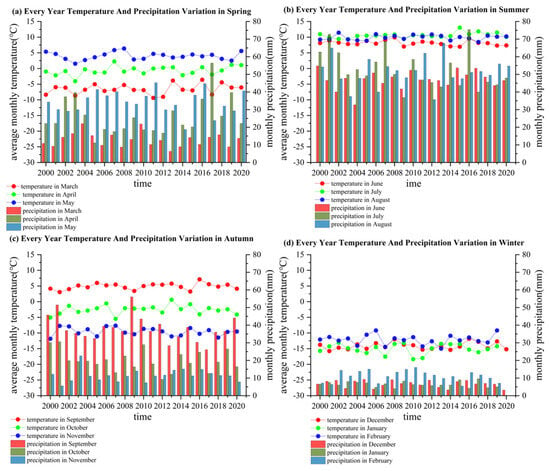
Figure 12.
The trends with time by month for temperature and precipitation.
The response of different glaciers to temperature and precipitation varies depending on regional terrain, glacier area, elevation, and other factors [60,61,62]. To analyze the main reasons for the spatial variation in GMB in the Tomur Peak Region in detail, this study provided a specific analysis of the autumn temperature and precipitation trend maps in the Tomur Peak Region from 2003–2020 (Figure 13). The temperature generally showed a distribution of south–high to north–low and west–low to east–high, with significant temperature increases in the south of Tomur and Koxkar, where the maximum rate of GSE variation (−1.65 ± 0.08 m/yr) in the study area occurred. The smallest temperature change was observed in the eastern and northwestern part of the study area, where there is more precipitation under the influence of the prevailing westerlies. The abundant precipitation compensates for the glacier mass loss, so the rate of GSE variation in this area is the smallest, at −0.4 ± 0.12 m/yr. As shown in Figure 13b, the precipitation generally showed a distribution of north–high to south–low and east–low to west–high. In a more detailed analysis, firstly, there was an overall decreasing trend of autumn precipitation but there was a significant positive change in precipitation in the northwest study area. Furthermore, the autumn rainfall was in an increasing state here from 2003–2020, and the rest of the area was in a negative state, especially in the southeast of the study area. From a comprehensive perspective, regions characterized by lower temperatures are associated with relatively higher levels of precipitation. Overall, the continuous ablation of GMB in the Tomur Peak Region during 2003–2020 was the result of the combined effect of temperature and precipitation. In addition, the obvious uneven distribution of temperature and precipitation due to the influence of the geographic environment of the study area has resulted in significant regional differences in GMB variations.
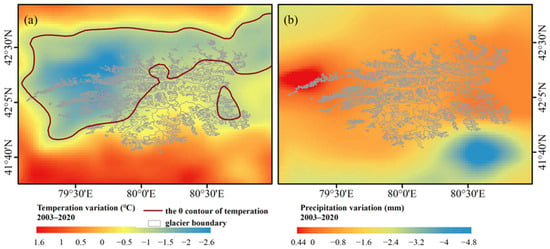
Figure 13.
Changes in average temperature and cumulative precipitation in the autumn for Tomur Peak Region from 2003–2020. The (a) is Changes in average temperature in the autumn. The (b) is cumulative precipitation in the autumn.
5. Conclusions
This paper employed ICESat-1/GLAS, ICESat-2/ATLAS, and CryoSat-2/SIRAL satellite altimetry data and ALOS PALSAR DEM as a datum elevation. It combined the three kinds of altimetry satellite data and the datum DEM to establish a time-series analysis model of glacier-zone surface elevation and obtained fitting GSE of the Tomur Peak Region in the period from 2003–2020. The fitting GSE was reconstructed in a time series, and finally, the GSE variations were converted into GMB by the mass conversion model. This study analyzed the variation pattern of GMB in different elevations and regions, combined with the temperature and precipitation data, then analyzed the driving factors of the GMB variations. The main conclusions are as follows:
(1) In this paper, a long time-series analytical model of GSE variation in the Tomur Peak Region was established by using ICESat-1/GLAS, CryoSat-2/SIRAL, and ICESat-2/ATLAS data. The results showed that the cumulative GSE variation was −8.95 ± 4.48 m in the Tomur Peak Region from 2003–2020, and the average annual rate was −0.52 ± 0.26 m/yr. The average annual rate of GSE variation from 2011–2020 (−0.41 ± 0.26 m/yr) was −0.52 ± 0.26 m/yr compared with that in 2003–2008 (−0.47 ± 0.32 m/yr). The average annual rate of GSE variation from 2011–2020 (−0.41 ± 0.26 m/yr) showed a slightly decreasing trend compared to 2003–2008 (−0.47 ± 0.32 m/yr).
(2) This paper estimated based on the annual rate of GSE variation at the altimetric points and derived the spatial distribution of GMB variation in the Tomur Peak Region. The results showed that the GMB in the Tomur Peak Region was −1.51 ± 0.04 Gt/yr in 2003–2020, −1.42 ± 0.05 Gt/yr in 2003–2008, and −1.15 ± 0.04 Gt/yr 2011–2020, respectively. The GMB variation gradually changed from negative to positive with the increasing elevation. The negative GMB was lower in 2011–2020 compared to 2003–2008, and the area affected by negative GMB had increased during 2003–2020, with a maximum decrease of −1.5 m/yr at the end of the Koxkar Glacier Tongue.
(3) In this study, the driving factors affecting GMB variations were analyzed in conjunction with temperature and precipitation data. The temperature and precipitation in the study area showed an overall increasing trend, with an increasing rate of 0.04 ± 0.02 °C/yr; the average annual precipitation was 26.08 mm, at a rate of 0.12 ± 0.06 mm/yr. The negative GMB in the Tomur Peak Region was mainly affected by the increasing regional temperature, and the weak annual increase in precipitation was not enough to compensate for the glacier mass loss due to the increasing temperature.
Author Contributions
Validation, C.C.; formal analysis, C.C. and W.D.; data curation, C.C.; writing-original draft, C.C.; methodology, and W.D.; investigation, and W.D.; resources, W.D.; supervision, W.D.; project administration, W.D., J.L., A.B. and W.G.; funding acquisition, W.D. and J.L.; writing review and editing, C.C., W.D., S.W., D.M. and Y.P. All authors have read and agreed to the published version of the manuscript.
Funding
This research was funded by the Joint Fund of Collaborative Innovation Center of Geo-Information Technology for Smart Central Plains, Henan Province; the Key Laboratory of Spatiotemporal Perception and processing, Ministry of Natural Resources under Grant No. 211102; the PI project of the Collaborative Innovation Center of Geo-Information Technology for Smart Central Plains, Henan Province under Grant 2020C002; the Fundamental Research Funds for the Universities of Henan Province under Grant NSFRF220424; the project of Provincial Key Technologies R & Program of Henan under Grant 222102320306; and the Doctoral Fund of Henan Polytechnic University under Grant B2022-8. At the same time, the research was also funded by the Tianshan Talent-Science and Technology Innovation Team, Grant No. 2022TSYCTD0006; the Third Integrated Scientific Expedition Project in Xinjiang, Grant No. 2021xjkk1403; in part by the Key program of International Cooperation, Bureau of International Cooperation, Chinese Academy of Sciences, Grant No. 1KYSB20210030; and the National Natural Science Foundation of China, Grant No. U203201, U22A20620/003. We thank them for their support for this research.
Data Availability Statement
The ICESat-1/GLA14 data presented in this study are openly available in the National Snow & Ice Data Center (NSIDC) at https://nsidc.org/data/glah14/versions/34/ (accessed on 10 April 2023). The ICESat-2/ATL06 data presented in this study are openly available in NSIDC at https://nsidc.org/data/icesat-2/ (accessed on 10 April 2023). The CryoSat-2 data presented in this study are openly available in the European Space Agency (ESA) at https://earth.esa.int/eogateway/missions/cryosat/data/ (accessed on 10 April 2023). The ALOS DEM data presented in this study are openly available in the Alaska Satellite Facility (ASF) data search portal at https://search.asf.alaska.edu/ (accessed on 1 November 2022). The Randolph Glacier Inventory (RGI) 6.0 presented in this study are openly available in the Global Land Ice Measurements from Space (GLIMS) website at http://www.glims.org/RGI/ (accessed on 6 November 2022). The fifth generation of ECMWF Atmospheric Reanalysis of Global Climate (ERA5) data presented in this study are openly available in ECMWF at https://cds.climate.copernicus.eu/ (accessed on 6 November 2022).
Acknowledgments
We thank the following agencies for their data that was available online. The ICESat-1/GLA14 can be downloaded from the National Snow & Ice Data Center (NSIDC) at https://nsidc.org/data/glah14/versions/34/ (accessed on 10 April 2023). The ICESat-2/ATL06 data used in this study can be downloaded from the NSIDC at https://nsidc.org/data/icesat-2/ (accessed on 10 April 2023). The CryoSat-2 can be downloaded from the European Space Agency (ESA) at https://earth.esa.int/eogateway/missions/cryosat/data/ (accessed on 10 April 2023). The ALOS DEM as a datum DEM can be downloaded from the Alaska Satellite Facility (ASF) Data Search portal at https://search.asf.alaska.edu/ (accessed on 1 November 2022). The Randolph Glacier Inventory (RGI) 6.0 can be accessed through the Global Land Ice Measurements from Space (GLIMS) website at http://www.glims.org/RGI/ (accessed on 6 November 2022). The fifth generation of ECMWF Atmospheric Reanalysis of Global Climate (ERA5) data was used to assess glacier change, with data obtained from https://cds.climate.copernicus.eu/ (accessed on 6 November 2022).
Conflicts of Interest
The authors declare no conflict of interest.
References
- Minchew, B.; Joughin, I. Toward a Universal Glacier Slip Law. Science 2020, 368, 29–30. [Google Scholar] [CrossRef] [PubMed]
- Yan, Q.; Owen, L.A.; Guo, C.; Zhang, Z.; Zhang, J.; Wang, H. Widespread Glacier Advances across the Tian Shan during Marine Isotope Stage 3 Not Supported by Climate-Glaciation Simulations. Fundam. Res. 2023, 3, 102–110. [Google Scholar] [CrossRef]
- Sugiyama, S.; Kanna, N.; Sakakibara, D.; Ando, T.; Asaji, I.; Kondo, K.; Wang, Y.; Fujishi, Y.; Fukumoto, S.; Podolskiy, E.; et al. Rapidly Changing Glaciers, Ocean and Coastal Environments, and Their Impact on Human Society in the Qaanaaq Region, Northwestern Greenland. Polar Sci. 2021, 27, 100632. [Google Scholar] [CrossRef]
- Mao, G.; Ji, M.; Jiao, N.; Su, J.; Zhang, Z.; Liu, K.; Chen, Y.; Liu, Y. Monsoon Affects the Distribution of Antibiotic Resistome in Tibetan Glaciers. Environ. Pollut. 2023, 317, 120809. [Google Scholar] [CrossRef] [PubMed]
- Thomson, L.; Brun, F.; Braun, M.; Zemp, M. Editorial: Observational Assessments of Glacier Mass Changes at Regional and Global Level. Front. Earth Sci. 2021, 8, 641710. [Google Scholar] [CrossRef]
- Talukder, B.; Matthew, R.; vanLoon, G.W.; Bunch, M.J.; Hipel, K.W.; Orbinski, J. Melting of Himalayan Glaciers and Planetary Health. Curr. Opin. Environ. Sustain. 2021, 50, 98–108. [Google Scholar] [CrossRef]
- Duan, H.; Yao, X.; Zhang, Y.; Jin, H.; Wang, Q.; Du, Z.; Hu, J.; Wang, B.; Wang, Q. Lake Volume and Potential Hazards of Moraine-Dammed Glacial Lakes–A Case Study of Bienong Co, Southeastern Tibetan Plateau. Cryosphere 2023, 17, 591–616. [Google Scholar] [CrossRef]
- Hussain, W.; Khan, M.A. Climate Change-Induced Glacial Lake Outburst Floods in Hunza Valley of Pakistan: An Assessment of Indigenous Farming Community Perceptions and Adaptation. Environ. Dev. Sustain. 2023, 25, 1–25. [Google Scholar] [CrossRef]
- Ji, Q.; Yan, S.; He, Y.; Lu, X.; Ma, Z. Spatio-Temporal Patterns of Snow Cover in the Tien Shan, China from 2000 to 2019 Based on Cloud-Free Data Supported by Google Earth Engine. Remote Sens. Lett. 2023, 14, 265–276. [Google Scholar] [CrossRef]
- Bai, C.; Wang, F.; Wang, L.; Xu, C.; Yue, X.; Yang, S.; Wang, P.; Bi, Y.; Wei, H. Dynamic Monitoring of Debris-Covered Glacier Surface Velocity and Ice Thickness of Mt. Tomur, Tian Shan, China. Remote Sens. 2022, 15, 150. [Google Scholar] [CrossRef]
- Zemp, M.; Hoelzle, M.; Haeberli, W. Six Decades of Glacier Mass-Balance Observations: A Review of the Worldwide Monitoring Network. Ann. Glaciol. 2009, 50, 101–111. [Google Scholar] [CrossRef]
- Yan, L.; Wang, J.; Shao, D. Glacier Mass Balance in the Manas River Using Ascending and Descending Pass of Sentinel 1A/1B Data and SRTM DEM. Remote Sens. 2022, 14, 1506. [Google Scholar] [CrossRef]
- Li, Z.; Wang, N.; Chang, J.; Zhang, Q. The Formation of an Ice-Contact Proglacial Lake and Its Impact on Glacier Change: A Case Study of the Tanymas Lake and Fedchenko Glacier. Remote Sens. 2023, 15, 2745. [Google Scholar] [CrossRef]
- Zhang, Y.; Chao, N.; Li, F.; Yue, L.; Wang, S.; Chen, G.; Wang, Z.; Yu, N.; Sun, R.; Ouyang, G. Reconstructing Long-Term Arctic Sea Ice Freeboard, Thickness, and Volume Changes from Envisat, CryoSat-2, and ICESat-2. JMSE 2023, 11, 979. [Google Scholar] [CrossRef]
- Zhang, Q.; Zhang, L.; Ouyang, Z.; Chen, Z.; Zhao, D.; Chen, W. Glacier Elevation Change during Two Periods in the Lenglongling Mountains Derived from Bistatic SAR Interferometry. Geocarto Int. 2022, 27, 1–14. [Google Scholar] [CrossRef]
- Berthier, E.; Arnaud, Y.; Baratoux, D.; Vincent, C.; Rémy, F. Recent Rapid Thinning of the “Mer de Glace” Glacier Derived from Satellite Optical Images: THINNING OF GLACIER FROM SATELLITE DATA. Geophys. Res. Lett. 2004, 31, L17401. [Google Scholar] [CrossRef]
- Wang, D.; Kääb, A. Modeling Glacier Elevation Change from DEM Time Series. Remote Sens. 2015, 7, 10117–10142. [Google Scholar] [CrossRef]
- Lhakpa, D.; Fan, Y.; Cai, Y. Continuous Karakoram Glacier Anomaly and Its Response to Climate Change during 2000–2021. Remote Sens. 2022, 14, 6281. [Google Scholar] [CrossRef]
- Ali, N.; Ye, Q.; Zhang, X.; Ji, X.; Hu, Y.; Zhu, L.; Ali, A. Glacier Changes in India’s Dhauliganga Catchment over the Past Two Decades. Remote Sens. 2022, 14, 5692. [Google Scholar] [CrossRef]
- Liu, L.; Jiang, L.; Wang, H.; Sun, Y. Existence of Glacier Anomaly in the Interior and Northern Tibetan Plateau between 2000 and 2012. Remote Sens. 2022, 14, 2962. [Google Scholar] [CrossRef]
- Erfani Jazi, Z.; Motagh, M.; Klemann, V. Inferring Mass Loss by Measuring Contemporaneous Deformation around the Helheim Glacier, Southeastern Greenland, Using Sentinel-1 InSAR. Remote Sens. 2022, 14, 3956. [Google Scholar] [CrossRef]
- KääB, A. Glacier Volume Changes Using ASTER Satellite Stereo and ICESat GLAS Laser Altimetry. IEEE Trans. Geosci. Remote Sens. 2008, 46, 2823–2830. [Google Scholar] [CrossRef]
- Slater, T.; Shepherd, A.; McMillan, M.; Leeson, A.; Gilbert, L.; Muir, A.; Munneke, P.K.; Noël, B.; Fettweis, X.; van den Broeke, M.; et al. Increased Variability in Greenland Ice Sheet Runoff from Satellite Observations. Nat. Commun. 2021, 12, 6069. [Google Scholar] [CrossRef] [PubMed]
- Wang, J.; Yang, Y.; Wang, C.; Li, L. Accelerated Glacier Mass Loss over Svalbard Derived from ICESat-2 in 2019–2021. Atmosphere 2022, 13, 1255. [Google Scholar] [CrossRef]
- Zhao, F.; Long, D.; Li, X.; Huang, Q.; Han, P. Rapid Glacier Mass Loss in the Southeastern Tibetan Plateau since the Year 2000 from Satellite Observations. Remote Sens. Environ. 2022, 270, 112853. [Google Scholar] [CrossRef]
- Fan, Y.; Ke, C.-Q.; Zhou, X.; Shen, X.; Yu, X.; Lhakpa, D. Glacier Mass-Balance Estimates over High Mountain Asia from 2000 to 2021 Based on ICESat-2 and NASADEM. J. Glaciol. 2022, 69, 1–13. [Google Scholar] [CrossRef]
- Goel, V.; Morris, A.; Moholdt, G.; Matsuoka, K. Synthesis of Field and Satellite Data to Elucidate Recent Mass Balance of Five Ice Rises in Dronning Maud Land, Antarctica. Front. Earth Sci. 2022, 10, 975606. [Google Scholar] [CrossRef]
- Pieczonka, T.; Bolch, T.; Kröhnert, M.; Peters, J.; Liu, S. Glacier Branch Lines and Glacier Ice Thickness Estimation for Debris-Covered Glaciers in the Central Tien Shan. J. Glaciol. 2018, 64, 835–849. [Google Scholar] [CrossRef]
- Zhang, Q.; Chen, Y.; Li, Z.; Fang, G.; Xiang, Y.; Li, Y.; Ji, H. Recent Changes in Water Discharge in Snow and Glacier Melt-Dominated Rivers in the Tienshan Mountains, Central Asia. Remote Sens. 2020, 12, 2704. [Google Scholar] [CrossRef]
- Baojuan, H.; Zhongqin, L.; Meiping, S.; Wenbin, W.; Shang, J.; Kaiming, L. Change in Glacier Area and Thickness in the Tomur Peak, Western Chinese Tien Shan over the Past Four Decades. J. Earth Syst. Sci. 2015, 124, 353–363. [Google Scholar] [CrossRef]
- Yang, S.; Wang, F.; Xie, Y.; Zhao, W.; Bai, C.; Liu, J.; Xu, C. Delineation Evaluation and Variation of Debris-Covered Glaciers Based on the Multi-Source Remote Sensing Images, Take Glaciers in the Eastern Tomur Peak Region for Example. Remote Sens. 2023, 15, 2575. [Google Scholar] [CrossRef]
- Li, Y.; Chen, Y.; Li, Z. Developing Daily Cloud-Free Snow Composite Products From MODIS and IMS for the Tienshan Mountains. Earth Space Sci. 2019, 6, 266–275. [Google Scholar] [CrossRef]
- Deng, G.; Tang, Z.; Hu, G.; Wang, J.; Sang, G.; Li, J. Spatiotemporal Dynamics of Snowline Altitude and Their Responses to Climate Change in the Tienshan Mountains, Central Asia, during 2001–2019. Sustainability 2021, 13, 3992. [Google Scholar] [CrossRef]
- Li, Z.; Li, J.; Ding, X.; Wu, L.; Ke, L.; Hu, J.; Xu, B.; Peng, F. Anomalous Glacier Changes in the Southeast of Tuomuer-Khan Tengri Mountain Ranges, Central Tianshan. J. Geophys. Res. Atmos. 2018, 123, 6840–6863. [Google Scholar] [CrossRef]
- Ma, Q.; Li, Z.; Lei, H.; Chen, Z.; Liu, J.; Wang, S.; Su, T.; Feng, G. Interannual Variability of Extreme Precipitation during the Boreal Summer over Northwest China. Remote Sens. 2023, 15, 785. [Google Scholar] [CrossRef]
- Ma, Q.; Li, Z.; Chen, Z.; Su, T.; Wu, Y.; Feng, G. Moisture Changes with Increasing Summer Precipitation in Qilian and Tienshan Mountainous Areas. Atmos. Sci. Lett. 2023, 24, e1154. [Google Scholar] [CrossRef]
- Sun, T.; Qi, J.; Huang, H. Discovering Forest Height Changes Based on Spaceborne Lidar Data of ICESat-1 in 2005 and ICESat-2 in 2019: A Case Study in the Beijing-Tianjin-Hebei Region of China. For. Ecosyst. 2020, 7, 53. [Google Scholar] [CrossRef]
- Chen, J.; Duan, Z. Monitoring Spatial-Temporal Variations of Lake Level in Western China Using ICESat-1 and CryoSat-2 Satellite Altimetry. Remote Sens. 2022, 14, 5709. [Google Scholar] [CrossRef]
- Magruder, L.; Neumann, T.; Kurtz, N. ICESat-2 Early Mission Synopsis and Observatory Performance. Earth Space Sci. 2021, 8, e2020EA001555. [Google Scholar] [CrossRef]
- Zhang, Y.; Pang, Y.; Cui, D.; Ma, Y.; Chen, L. Accuracy Assessment of the ICESat-2/ATL06 Product in the Qilian Mountains Based on CORS and UAV Data. IEEE J. Sel. Top. Appl. Earth Obs. Remote Sens. 2021, 14, 1558–1571. [Google Scholar] [CrossRef]
- Satake, Y.; Nakamura, K. Temporal Variations in Ice Thickness of the Shirase Glacier Derived from Cryosat-2/SIRAL Data. Remote Sensing 2023, 15, 1205. [Google Scholar] [CrossRef]
- Morris, A.; Moholdt, G.; Gray, L. Spread of Svalbard Glacier Mass Loss to Barents Sea Margins Revealed by CryoSat-2. J. Geophys. Res. Earth Surf. 2020, 125, e2019JF005357. [Google Scholar] [CrossRef]
- Meloni, M.; Bouffard, J.; Parrinello, T.; Dawson, G.; Garnier, F.; Helm, V.; Di Bella, A.; Hendricks, S.; Ricker, R.; Webb, E.; et al. CryoSat Ice Baseline-D Validation and Evolutions. Cryosphere 2020, 14, 1889–1907. [Google Scholar] [CrossRef]
- Müller, F.L.; Paul, S.; Hendricks, S.; Dettmering, D. Monitoring Arctic Thin Ice: A Comparison between CryoSat-2 SAR Altimetry Data and MODIS Thermal-Infrared Imagery. Cryosphere 2023, 17, 809–825. [Google Scholar] [CrossRef]
- Du, W.; Liu, X.; Guo, J.; Shen, Y.; Li, W.; Chang, X. Analysis of the Melting Glaciers in Southeast Tibet by ALOS-PALSAR Data. Terr. Atmos. Ocean. Sci. 2019, 30, 7–19. [Google Scholar] [CrossRef]
- Singh, G.; Nela, B.R.; Bandyopadhyay, D.; Mohanty, S.; Kulkarni, A.V. Discovering Anomalous Dynamics and Disintegrating Behaviour in Glaciers of Chandra-Bhaga Sub-Basins, Part of Western Himalaya Using DInSAR. Remote Sens. Environ. 2020, 246, 111885. [Google Scholar] [CrossRef]
- Xie, Z.; Haritashya, U.K.; Asari, V.K.; Young, B.W.; Bishop, M.P.; Kargel, J.S. GlacierNet: A Deep-Learning Approach for Debris-Covered Glacier Mapping. IEEE Access 2020, 8, 83495–83510. [Google Scholar] [CrossRef]
- Doke, R.; Kikugawa, G.; Itadera, K. Very Local Subsidence Near the Hot Spring Region in Hakone Volcano, Japan, Inferred from InSAR Time Series Analysis of ALOS/PALSAR Data. Remote Sens. 2020, 12, 2842. [Google Scholar] [CrossRef]
- Li, F.; Maussion, F.; Wu, G.; Chen, W.; Yu, Z.; Li, Y.; Liu, G. Influence of Glacier Inventories on Ice Thickness Estimates and Future Glacier Change Projections in the Tian Shan Range, Central Asia. J. Glaciol. 2023, 69, 266–280. [Google Scholar] [CrossRef]
- Zhang, D.; Zhou, G.; Li, W.; Zhang, S.; Yao, X.; Wei, S. A New Global Dataset of Mountain Glacier Centerlines and Lengths. Earth Syst. Sci. Data 2022, 14, 3889–3913. [Google Scholar] [CrossRef]
- Bonshoms, M.; Ubeda, J.; Liguori, G.; Körner, P.; Navarro, Á.; Cruz, R. Validation of ERA5-Land Temperature and Relative Humidity on Four Peruvian Glaciers Using on-Glacier Observations. J. Mt. Sci. 2022, 19, 1849–1873. [Google Scholar] [CrossRef]
- Gurdiel, I.; Rada, C.; Malz, P.; Braun, M.; Casassa, G. Glacier Inventory and Recent Variations of Santa Inés Icefield, Southern Patagonia. Arct. Antarct. Alp. Res. 2022, 54, 202–220. [Google Scholar] [CrossRef]
- Hersbach, H.; Bell, B.; Berrisford, P.; Hirahara, S.; Horányi, A.; Muñoz-Sabater, J.; Nicolas, J.; Peubey, C.; Radu, R.; Schepers, D.; et al. The ERA5 Global Reanalysis. Q. J. R. Meteorol. Soc. 2020, 146, 1999–2049. [Google Scholar] [CrossRef]
- Du, W.; Zheng, Y.; Li, Y.; Bao, A.; Li, J.; Ma, D.; Gao, X.; Pan, Y.; Wang, S. Recent Seasonal Spatiotemporal Variations in Alpine Glacier Surface Elevation in the Pamir. Remote Sens. 2022, 14, 4923. [Google Scholar] [CrossRef]
- Shen, C.; Jia, L.; Ren, S. Inter- and Intra-Annual Glacier Elevation Change in High Mountain Asia Region Based on ICESat-1&2 Data Using Elevation-Aspect Bin Analysis Method. Remote Sens. 2022, 14, 1630. [Google Scholar] [CrossRef]
- Zhen, W.; Huiwen, Z.; Shiyin, L.; Junyin, C. Influence of Debris Cover on Glacier Response to Climate Change: Insights from Koxkar Glacier Using Dynamic Simulation. Arab. J. Geosci. 2019, 12, 506. [Google Scholar] [CrossRef]
- Cai, X.; Xu, C.; Li, Z. Glacier Changes and Its Effect on Water Resources in the Upper Reaches of Aksu River, Tien Shan, China, from 1989 to 2016. Arab. J. Geosci. 2022, 15, 565. [Google Scholar] [CrossRef]
- Chen, J.; Du, W.; Kang, S.; Qin, X.; Sun, W.; Liu, Y.; Luo, L.; He, J.; Jiang, Y.; Sun, W. Comparison of Energy and Mass Balance Characteristics between Two Glaciers in Adjacent Basins in the Qilian Mountains. Clim. Dyn. 2023, 61, 1535–1550. [Google Scholar] [CrossRef]
- Zhang, Q.; Chen, Y.; Li, Z.; Li, Y.; Xiang, Y.; Bian, W. Glacier Changes from 1975 to 2016 in the Aksu River Basin, Central Tianshan Mountains. J. Geogr. Sci. 2019, 29, 984–1000. [Google Scholar] [CrossRef]
- Wang, J.; Tang, Z.; Deng, G.; Hu, G.; You, Y.; Zhao, Y. Landsat Satellites Observed Dynamics of Snowline Altitude at the End of the Melting Season, Himalayas, 1991–2022. Remote Sens. 2023, 15, 2534. [Google Scholar] [CrossRef]
- Hayat, H.; Raup, B.; Muhammad, S.; Liu, S.; Khan, R.; Baig, S.U.; Ahmad Tahir, A. Heterogeneous Mass Balance of Selected Glaciers in the Hindu Kush, Karakoram, and Himalaya between 2000 and 2018. Eur. J. Remote Sens. 2023, 56, 2173086. [Google Scholar] [CrossRef]
- Vincent, C.; Thibert, E. Brief Communication: Non-Linear Sensitivity of Glacier Mass Balance to Climate Attested by Temperature-Index Models. Cryosphere 2023, 17, 1989–1995. [Google Scholar] [CrossRef]
Disclaimer/Publisher’s Note: The statements, opinions and data contained in all publications are solely those of the individual author(s) and contributor(s) and not of MDPI and/or the editor(s). MDPI and/or the editor(s) disclaim responsibility for any injury to people or property resulting from any ideas, methods, instructions or products referred to in the content. |
© 2023 by the authors. Licensee MDPI, Basel, Switzerland. This article is an open access article distributed under the terms and conditions of the Creative Commons Attribution (CC BY) license (https://creativecommons.org/licenses/by/4.0/).